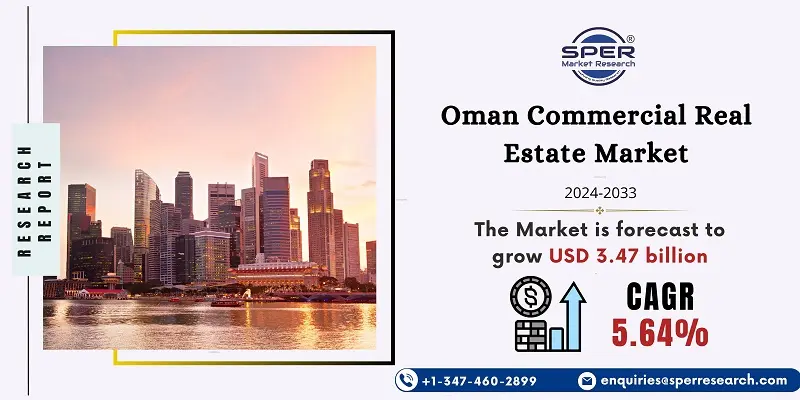
Oman Commercial Real Estate Market Trends, Share, Size, Demand, Revenue and Future Outlook
Oman Commercial Real Estate Market Growth, Size, Trends Analysis- By Type- Regional Outlook, Competitive Strategies and Segment Forecast to 2033
| Published: Nov-2024 | Report ID: BFSI2430 | Pages: 1 - 107 | Formats*: |
| Category : BFSI | |||
- The Grand Blue City Development Company, supported by the sovereign wealth fund Oman Investment Authority (OIA), resumed the long-delayed Blue City project in Oman in November 2023. The Arabic acronym BAT is another name for the project.
- The Oman Tourism Development Company (Omran) declared in July 2023 that it would hire a multidisciplinary consultant to carry out a concept masterplan for the entire site and to produce a comprehensive masterplan and comprehensive architectural design guidelines for the mixed-use town of Madinat Al Irvine East.


| Report Metric | Details |
| Market size available for years | 2020-2033 |
| Base year considered | 2023 |
| Forecast period | 2024-2033 |
| Segments covered | By Type |
| Regions covered | Eastern region, Western region, Southern region, Northern region. |
| Companies Covered | Al Osool Group, Al Tamman Real Estate, Alfardan Group, Al-Taher Group, BBH Group, Diamonds Real Estate, Hamptons International & Partners LLC, Malik Developments, Omran Group, Shanfari Group, Others. |
- Institutional Investors
- Real Estate Developers
- Property Managers
- Corporate Tenants
- Retailers
- Government Agencies
- Financial Institutions
- Real Estate Brokers and Agents
| By Type: |
- Oman Commercial Real Estate Market Size (FY’2024-FY’2033)
- Overview of Oman Commercial Real Estate Market
- Segmentation of Oman Commercial Real Estate Market By Type (Offices, Retail, Industrial, Logistics, Multi-family, Hospitality)
- Expansion Analysis of Oman Commercial Real Estate Market
- Problems and Obstacles in Oman Commercial Real Estate Market
- Competitive Landscape in the Oman Commercial Real Estate Market
- Impact of COVID-19 and Demonetization on Oman Commercial Real Estate Market
- Details on Current Investment in Oman Commercial Real Estate Market
- Competitive Analysis of Oman Commercial Real Estate Market
- Prominent Players in the Oman Commercial Real Estate Market
- SWOT Analysis of Oman Commercial Real Estate Market
- Oman Commercial Real Estate Market Future Outlook and Projections (FY’2024-FY’2033)
- Recommendations from Analyst
1.1. Scope of the report1.2. Market segment analysis
2.1. Research data source
2.1.1. Secondary Data2.1.2. Primary Data2.1.3. SPERs internal database2.1.4. Premium insight from KOLs
2.2. Market size estimation
2.2.1. Top-down and Bottom-up approach
2.3. Data triangulation
4.1. Driver, Restraint, Opportunity and Challenges analysis
4.1.1. Drivers4.1.2. Restraints4.1.3. Opportunities4.1.4. Challenges
4.2. COVID-19 Impacts of the Oman Commercial Real Estate Market
5.1. SWOT Analysis
5.1.1. Strengths5.1.2. Weaknesses5.1.3. Opportunities5.1.4. Threats
5.2. PESTEL Analysis
5.2.1. Political Landscape5.2.2. Economic Landscape5.2.3. Social Landscape5.2.4. Technological Landscape5.2.5. Environmental Landscape5.2.6. Legal Landscape
5.3. PORTERs Five Forces
5.3.1. Bargaining power of suppliers5.3.2. Bargaining power of buyers5.3.3. Threat of Substitute5.3.4. Threat of new entrant5.3.5. Competitive rivalry
5.4. Heat Map Analysis
6.1. Oman Commercial Real Estate Market Manufacturing Base Distribution, Sales Area, Product Type6.2. Mergers & Acquisitions, Partnerships, Product Launch, and Collaboration in Oman Commercial Real Estate Market
7.1. Oman Commercial Real Estate Market Size, Share and Forecast, By Type, 2020-20267.2. Oman Commercial Real Estate Market Size, Share and Forecast, By Type, 2027-20337.3. Offices7.4. Retail7.5. Industrial7.6. Logistics7.7. Multi-family7.8. Hospitality
8.1. Oman Commercial Real Estate Market Size and Market Share
9.1. Oman Commercial Real Estate Market Size and Market Share By Region (2020-2026)9.2. Oman Commercial Real Estate Market Size and Market Share By Region (2027-2033)9.3. Eastern Region9.4. Western Region9.5. Southern Region9.6. Northern Region
10.1. Al Osool Group
10.1.1. Company details10.1.2. Financial outlook10.1.3. Product summary10.1.4. Recent developments
10.2. Al Tamman Real Estate
10.2.1. Company details10.2.2. Financial outlook10.2.3. Product summary10.2.4. Recent developments
10.3. Alfardan Group
10.3.1. Company details10.3.2. Financial outlook10.3.3. Product summary10.3.4. Recent developments
10.4. Al-Taher Group
10.4.1. Company details10.4.2. Financial outlook10.4.3. Product summary10.4.4. Recent developments
10.5. BBH Group
10.5.1. Company details10.5.2. Financial outlook10.5.3. Product summary10.5.4. Recent developments
10.6. Diamonds Real Estate
10.6.1. Company details10.6.2. Financial outlook10.6.3. Product summary10.6.4. Recent developments
10.7. Hamptons International & Partners LLC
10.7.1. Company details10.7.2. Financial outlook10.7.3. Product summary10.7.4. Recent developments
10.8. Malik Developments
10.8.1. Company details10.8.2. Financial outlook10.8.3. Product summary10.8.4. Recent developments
10.9. Omran Group
10.9.1. Company details10.9.2. Financial outlook10.9.3. Product summary10.9.4. Recent developments
10.10. Shanfari Group
10.10.1. Company details10.10.2. Financial outlook10.10.3. Product summary10.10.4. Recent developments
10.11. Others
SPER Market Research’s methodology uses great emphasis on primary research to ensure that the market intelligence insights are up to date, reliable and accurate. Primary interviews are done with players involved in each phase of a supply chain to analyze the market forecasting. The secondary research method is used to help you fully understand how the future markets and the spending patterns look likes.
The report is based on in-depth qualitative and quantitative analysis of the Product Market. The quantitative analysis involves the application of various projection and sampling techniques. The qualitative analysis involves primary interviews, surveys, and vendor briefings. The data gathered as a result of these processes are validated through experts opinion. Our research methodology entails an ideal mixture of primary and secondary initiatives.



Frequently Asked Questions About This Report
PLACE AN ORDER
Year End Discount
Sample Report
Pre-Purchase Inquiry
NEED CUSTOMIZATION?
Request CustomizationCALL OR EMAIL US
100% Secure Payment






Related Reports
Our Global Clients
Our data-driven insights have influenced the strategy of 200+ reputed companies across the globe.






















